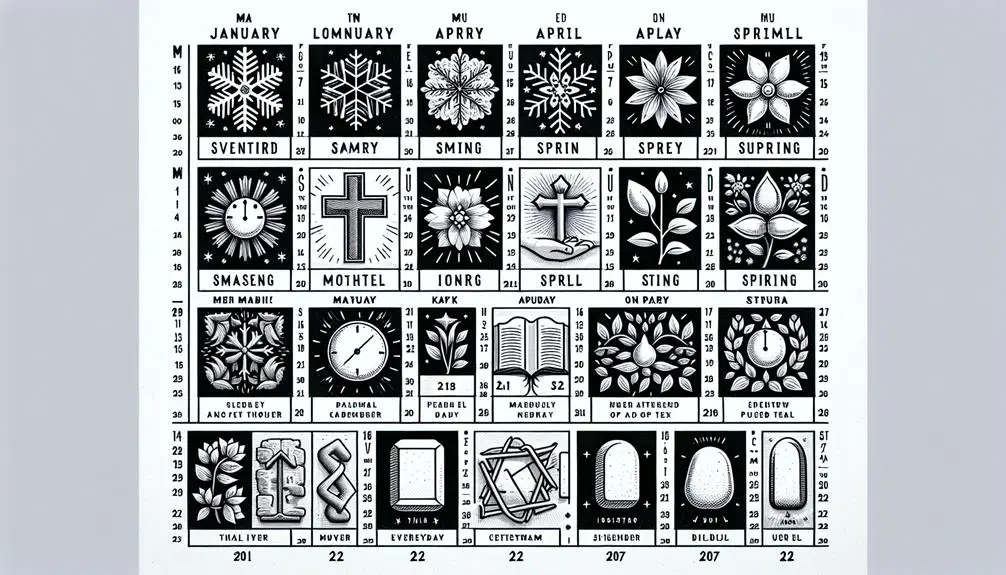Begin a transformative journey with a chronological Bible reading plan, and unveil historical insights that will refresh your spiritual understanding.

Read Through the Bible in a Year Chronological Printable Schedule
Embarking on a journey through the Bible in a chronological order presents an enriching opportunity to understand the historical flow of biblical events, providing a unique perspective on its teachings and narratives.
A structured, year-long plan, complemented by a printable schedule, not only organizes this endeavor but also enhances comprehension and retention.
As we explore the intricacies of crafting such a schedule, including the considerations for chronological sequencing and the integration of reflective practices, one might ponder the transformative potential of this disciplined approach.
How does aligning the biblical stories with their historical context influence our interpretation and what unforeseen insights await?
Key Takeaways
- A chronological reading plan organizes Bible events in historical order for a comprehensive understanding.
- Structured plans enhance comprehension and ensure steady progress through scripture in one year.
- Preparation involves choosing a suitable Bible translation and integrating reading into daily routines.
- Staying motivated with digital tools and community readings can enrich the chronological reading experience.
Understanding Chronological Reading

Chronological reading of the Bible involves systematically progressing through biblical events in the order they historically occurred, offering a coherent and comprehensive understanding of the scripture's narrative structure. This method stands in contrast to thematic or canonical readings, which either group texts by topic or follow the traditional sequence of books as found in most Bibles. By situating the biblical narratives within their historical context, readers are afforded a unique vantage point from which to discern the development of theological concepts and the unfolding of God's relationship with humanity over time.
The chronological approach necessitates a meticulous examination of biblical chronology, requiring scholars to delve into historical records, archaeological findings, and biblical text analysis. This scholarly endeavor aims to reconstruct the timeline of biblical events with as much accuracy as contemporary research and ancient evidence allow. Such a reconstruction is not without its challenges, given the complexities inherent in dating ancient events and the occasional lack of explicit temporal markers within the biblical text itself.
Understanding the narrative structure of the Bible through a chronological lens also illuminates the interconnectedness of its various books and passages. It reveals how earlier events set the stage for later developments, offering insights into the causality and thematic continuity that might be less apparent in non-chronological readings. By appreciating the historical context and narrative structure of the Bible in this way, readers can gain a deeper understanding of the scripture's meaning and its application to both ancient and contemporary life.
Benefits of a Structured Plan

While understanding the chronological structure of the Bible enhances comprehension of its narrative, adopting a structured reading plan further amplifies this understanding by systematically guiding readers through the scriptures. A structured plan not only offers a coherent sequence but also integrates both flexible scheduling and the potential for spontaneous discoveries, enriching the reading experience.
Here are several benefits of such an approach:
- Enhanced Comprehension: By following a structured plan, readers can appreciate the historical context and development of biblical themes more deeply. This methodical progression aids in grasping the intricate connections between events and teachings, providing a more comprehensive understanding of the Bible's message.
- Consistent Progress: A structured plan ensures that readers maintain a steady pace, preventing the common pitfalls of random or sporadic reading. This consistency is vital for completing the Bible in a set timeframe, such as a year, making the goal attainable and less daunting.
- Flexible Scheduling: While the plan provides structure, it also allows for flexibility. Readers can adjust their reading schedule to accommodate their daily routines, making it easier to stay committed without feeling overwhelmed. This adaptability enhances engagement and persistence in the reading journey.
- Spontaneous Discoveries: Although the reading is structured, it leaves room for spontaneous insights. As readers progress, they may uncover unexpected connections or revelations within the scriptures, adding an element of surprise and depth to their study.
Preparing for Your Journey

Embarking on a structured Bible reading plan requires careful preparation to ensure a fruitful and enlightening journey through the scriptures. One of the foundational steps in this preparatory phase involves choosing translations. The selection of a Bible translation is not merely a matter of personal preference but should be informed by the reader's objectives and the text's intended use. For in-depth study, a translation that stays closer to the source languages (such as the English Standard Version or the New American Standard Bible) might be preferable. Conversely, for a more narrative reading experience, dynamic translations (like the New Living Translation) can offer accessibility and ease of understanding.
Equally critical to the preparation process is the act of setting priorities. This entails not only allocating specific times of the day for reading but also determining the spiritual or educational goals one aims to achieve. Whether the aim is to enhance doctrinal understanding, foster a deeper spiritual connection, or simply gain a comprehensive overview of the biblical narrative, clear objectives guide the reading process and enhance its outcomes.
Moreover, setting priorities includes the practical aspect of organizing one's life to accommodate this commitment. It may involve reducing or rearranging leisure activities, utilizing technology for reminders, or even seeking a community of readers for support and discussion. The deliberate act of prioritizing Bible reading within daily life underscores the significance of this spiritual discipline, ensuring that it becomes an integral, rather than peripheral, component of the reader's daily routine.
Monthly Reading Breakdown

In the progression of establishing a comprehensive Bible reading schedule, the Monthly Reading Breakdown serves as a critical framework for achieving set objectives. This segment will systematically explore the structuring of monthly goals, providing a scaffold that ensures a consistent pacing across various thematic and canonical areas.
Additionally, insight into weekly focus points and daily reading strategies will be discussed, aiming to enhance comprehension and retention, thus facilitating a more profound engagement with the scriptural texts.
Monthly Goals Overview
To establish a comprehensive understanding of biblical texts, setting monthly goals for reading can provide a structured approach to exploration and study. This structured approach entails a careful consideration of several key factors:
- Book Selection: Identifying which books of the Bible to read each month is crucial. This selection can be influenced by thematic or chronological considerations, ensuring a cohesive understanding of the text.
- Reading Pace: Determining a realistic pace that accommodates personal schedules while fostering deep engagement with the text is essential.
- Integration of Supplementary Materials: To enhance comprehension, integrating commentaries or study guides can be beneficial.
- Reflection and Application: Setting aside time for reflection on the readings and contemplating their application in modern contexts.
This methodical approach encourages a deeper, more meaningful interaction with biblical texts.
Weekly Focus Areas
Having outlined the approach for setting monthly goals in Bible study, it is equally important to break down these goals into weekly focus areas to ensure systematic progress. This methodical division allows for an in-depth exploration of the scriptures, integrating seasonal themes and cultural insights that enrich the reader's understanding and engagement.
For instance, dedicating a week to the study of Passover in Exodus can illuminate its significance in both historical and contemporary contexts, offering a richer appreciation of its cultural impact. Similarly, focusing on the Advent narratives during the weeks leading to Christmas can deepen one's comprehension of their theological implications.
This approach not only enhances the learning experience but also fosters a more nuanced grasp of the Bible's multifaceted teachings.
Daily Reading Tips
Breaking down monthly Bible study goals into manageable daily reading tips can significantly enhance one's ability to absorb and reflect upon the scriptural passages in a more profound and meaningful way. To achieve this, consider the following:
- Optimize Reading Environment: Designate a tranquil, distraction-free area to foster concentration and spiritual reflection.
- Adhere to Selection Criteria: Prioritize passages based on thematic relevance or chronological order to ensure a structured progression.
- Set Realistic Timelines: Allocate specific durations for daily reading, allowing for thoughtful meditation on the texts.
- Incorporate Reflective Practices: Engage in journaling or discussion to deepen understanding and application of biblical teachings.
These strategies, founded on analytical and scholarly principles, promise a more enriching and comprehensive engagement with the Bible.
Staying Motivated and Engaged

Maintaining motivation and engagement during a Bible reading schedule requires understanding the intrinsic value and personal benefits derived from consistent study. The process of reading through the Bible in a year can be both enriching and demanding. To sustain interest and dedication, individuals may employ various strategies, such as participating in group readings or utilizing digital tools. These methods offer unique advantages in fostering a supportive environment and enhancing the reading experience.
Strategy |
Benefits |
|---|---|
Group Readings |
Encourages accountability, fosters community |
Digital Tools |
Offers flexibility, provides interactive content |
Group readings create a sense of community and accountability among participants. This shared journey can lead to deeper discussions, diverse perspectives, and mutual encouragement. Additionally, the collective experience can strengthen personal resolve and provide a platform for insightful exchanges, enriching the overall understanding of the scriptures.
Digital tools, on the other hand, introduce a level of flexibility and interactivity that traditional methods may lack. Applications and websites designed for Bible study can offer personalized reading plans, progress tracking, and access to a wide range of resources. Features such as audio Bibles, commentaries, and translation comparisons can significantly enhance one's engagement with the text. These tools cater to various learning styles and preferences, making the scripture more accessible and appealing.
Reflecting on Your Progress
As individuals employ strategies to stay motivated and engaged in their Bible reading schedules, it becomes crucial to periodically evaluate their progress and the impact of these methods on their spiritual growth. Reflecting on one's journey through the scriptures not only reinforces commitment but also illuminates areas for further exploration and understanding. This reflection process can be enriched by:
- Journaling Thoughts: The act of writing down insights, questions, and revelations as one progresses through the Bible serves as a tangible record of spiritual growth. Journaling enables individuals to track changes in their understanding and beliefs over time. It encourages a deeper engagement with the text, making abstract concepts more concrete and personal.
- Community Discussions: Participating in group discussions about the Bible can provide new perspectives and insights that one might not have considered. This communal approach to reflection fosters a sense of belonging and accountability, which can be especially motivating.
- Setting Milestones: Establishing and celebrating milestones within the reading schedule can offer a sense of achievement and motivation. Whether it's completing a challenging book or reaching the halfway point, acknowledging these achievements reinforces commitment.
- Regular Review Sessions: Setting aside time to review past notes and journal entries can reveal patterns in one's spiritual journey. This practice may highlight recurring themes or questions, guiding future studies and personal growth.
Incorporating these reflective practices into one's Bible reading routine not only enhances understanding but also solidifies the habit, making the spiritual journey more meaningful and rewarding.
Frequently Asked Questions
How Can I Catch up if I Fall Significantly Behind on the Chronological Reading Schedule?
To catch up when falling significantly behind on a chronological reading agenda, one could employ speed reading techniques to efficiently process text while retaining comprehension.
Additionally, strategically allocating break days can serve to recalibrate the reading schedule without overwhelming the reader.
This approach allows for flexibility and adaptability in managing the reading workload, ensuring that the reader can maintain progress towards their goal without compromising the depth of their engagement with the material.
Are There Any Recommended Apps or Digital Tools That Integrate With This Chronological Bible Reading Plan?
In the realm of digital augmentation, several apps and tools stand out for their seamless integration with chronological bible reading plans. These platforms typically offer features such as digital bookmarks, which enable users to effortlessly navigate through their readings, and reading analytics, providing insightful data on reading patterns and progress.
Such tools enhance the user experience through meticulous organization and personalized tracking, thus enriching the spiritual journey through the scriptures.
If I Start the Plan in the Middle of the Year, How Should I Adjust the Schedule to Still Complete It Within a Year?
Initiating a chronological Bible reading plan mid-year necessitates strategic adjustments to ensure completion within the designated timeframe. Key adjustment strategies include doubling daily reading sessions or extending the plan's duration to accommodate the mid-year start.
Analyzing the plan's structure to identify shorter segments for consolidation or days where additional readings can be accommodated may further optimize the schedule, ensuring the chronological integrity of the scriptures is maintained throughout the adaptation process.
How Can I Involve My Family or a Small Group in Following This Chronological Reading Plan Together?
To encourage collective participation in a chronological reading plan, incorporating group incentives and utilizing discussion prompts are effective strategies. Group incentives motivate participation through shared goals or rewards, fostering a sense of community and accountability.
Discussion prompts, meanwhile, deepen engagement by encouraging critical thinking and reflection on the readings. These tools not only enhance comprehension but also promote a collaborative learning environment, making the reading journey a shared, enriching experience for all participants.
Can This Chronological Bible Reading Plan Be Adapted for Shorter Time Frames, Such as Six Months or Less?
Adapting a chronological Bible reading plan for condensed time frames, such as six months or less, necessitates an analytical consideration of reading speed and daily commitment.
Accelerating the timeline requires participants to significantly increase their daily reading load, directly impacting their daily commitment.
This adjustment must be strategically planned to maintain comprehension and engagement, ensuring the essence of the chronological narrative is retained without overwhelming the reader.
Conclusion
In conclusion, the adoption of a chronological reading schedule for traversing the biblical texts presents a structured pathway to deeper comprehension and engagement with the narratives.
This methodical approach facilitates a sequential understanding, illuminating the historical context and progression of events in a manner that traditional reading plans might not offer.
Thus, individuals are equipped with a more profound appreciation of the theological and historical nuances, enhancing both their spiritual journey and scholarly pursuit of biblical literacy.



Sign up